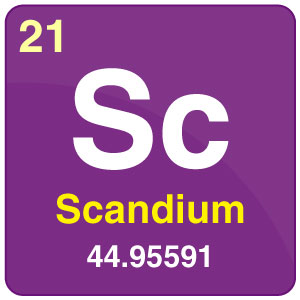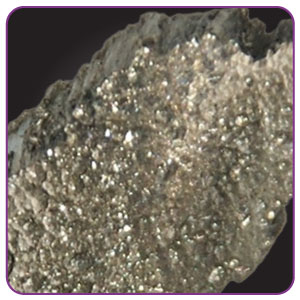Scandium

| Symbol | Sc |
| Atomic Number | 21 |
| Atomic Mass | 44.955 908(5) |
| Discovered by | Lars Frederik Nilson in 1879 |

Table of Contents
- What is Scandium?
- Chemical Properties of Scandium
- Uses of Scandium
- Properties of Scandium
- Certain Facts about Scandium
- Recommended Videos
What is Scandium?
- Scandium is an element with the atomic number 21 and represented by the symbol ‘Sc‘ in the periodic table.
- Scandium is mined from one of the rare minerals from Scandinavia. The colour it develops when exposed to air is yellowish or pinkish cast. One of the characteristics of Scandium is it gets tarnished and burned easily if ignited. It also reacts with hydrogen gas and will dissolve in acids.
- Heating scandium fluoride (ScF3) with calcium metal produces pure Scandium. This rare chemical can be found in a house in equipment like glasses, energy-saving lamps, fluorescent lamps, and television.
- Scandium has been shown to reduce solidification cracking during welding of high-strength aluminium alloys. Usage of scandium is increasing as is a well-suited catalyzer to polish glass. Aluminium scandium alloys are the primary application for the aerospace industry and sports equipment (like baseball, bikes, etc.)
- Scandium occurs in a very small amount in nature. It has been labelled as the 50th most abundant element on Earth, distributed widely in trace quantities in over 800 minerals. The total production will amount to only 50 kg per year.
Chemical Properties of Scandium
| Group | 3 | Melting point | 1541°C, 2806°F, 1814 K |
| Period | 4 | Boiling point | 2836°C, 5137°F, 3109 K |
| Block | d | Density (g cm−3) | 2.99 |
| Atomic number | 21 | Relative atomic mass | 44.956 |
| State at 20°C | Solid | Key isotopes | 45Sc |
| Electron configuration | [Ar]3d1 4s2 | CAS number | 7440-20-2 |
| ChemSpider ID | 22392 | ChemSpider is a free chemical structure database | |
Uses of Scandium
- This transition metal has been heard to have only a few uses owing to its limited availability and high costs.
- Since it has a high melting point and low density, it would be mainly used in the form of an alloying agent in the category of metals (lightweight) for applications of high performance and military purposes.
- Apart from this, this metal is widely used as an alloy additive to alloys that are aluminium based for making metal halide lamps of high intensity and sporting goods.
- Scandium would limit the grain growth of high temperature, once alloyed with aluminium and aluminium-based ones.
Properties of Scandium
- The metal has a silvery-white appearance while having a moderately soft texture.
- Owing to the formation of Sc2O3 oxide on its surface, its stability in air changes slowly to a yellowish form.
- Except for hydrofluoric acid (HF) which has a protective trifluoride layer that deters additional reaction, this metal dissolves slowly in acids that are diluted.
- The metal has a paramagnetic nature viz. from 0 K −273 °C/−460 °F) to the melting point of 1,541 °C/ 2,806 °F.
- Once the pressure exceeds 186 kilobars, the metal turns into a superconductor at −273.1 °C (−459.6 °F).
Certain Facts about Scandium
- The metal is named after Scandinavia by its discoverer Lars Fredrik Nilson in 1879
- Until 1960, 99.9 percent of the metal was not isolated.
- Scandium is the fiftieth most abundant element on the planet.
- Its existence was originally predicted by Dmitri Mendeleev ten years before its actual discovery in the Mendeleev periodic table.
- Scandium has thirteen isotopes.
- Most isotopes of this metal have a half-life of two minutes or less.
Recommended Videos



Comments